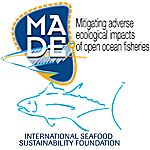A 73-day research cruise was undertaken by scientists of the Inter-American Tropical Tuna Commission, during the period of 11 May to 23 July, 2011 to the equatorial eastern Pacific Ocean aboard the Ecuadorian-flag purse-seine vessel Yolanda L., under a charter agreement between the vessel owner and the International Seafood Sustainability Foundation. The objectives of the cruise included attempting to reveal practical solutions for reducing the fishing mortality of undesirable sizes of bigeye and yellowfin, sharks, and other species of concern commonly captured during fishing operations by purse-seine vessels setting on mixed-species aggregations associated with drifting fish-aggregating devices (FADs).
One of the research activities during the cruise was to elucidate fine-scale spatial and temporal differences in the behavior of bigeye, skipjack, and yellowfin tunas within mixed-species aggregations associated with drifting FADs. Ultrasonic telemetry experiments were undertaken at ten drifting FADs, with large mixed-species tuna aggregations present. Experimental methods included the capture and tagging with VEMCO V13P coded ultrasonic transmitters, of up to 3 each of bigeye, skipjack, and yellowfin tunas, and continuous ultrasonic transmitters, in up to 3 additional skipjack. VEMCO VR2 and VR28 acoustic receivers were utilized for the passive and active ultrasonic telemetry experiments. Each experiment was intended to be conducted for a minimum of 48 h. Analyses of the ultrasonic telemetry data obtained from these experiments will be presented, along with evaluations and discussion of the simultaneous behavior of the three tuna species.
- Presentation

 PDF version
PDF version
